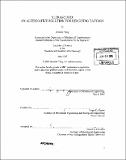Ultrasound : an alternative solution for removing tattoos
Author(s)
Teng, Jennifer
DownloadFull printable version (5.338Mb)
Other Contributors
Massachusetts Institute of Technology. Dept. of Mechanical Engineering.
Advisor
Roger D. Kamm.
Terms of use
Metadata
Show full item recordAbstract
The recent influx of tattoos has been accompanied by a rise in demand for tattoo removals. Due to the recent success of ultrasound as a noninvasive alternative for multiple medical therapies, the feasibility of ultrasound-mediated tattoo removals will be investigated in this thesis. During tattoo applications, dermal cells consume and store tattoo particles in vacuoles in the same manner fat cells store lipids. It is therefore assumed that tattooed cells adopt an "effective density" analogous to the way fat cells develop a lower density. Using this change in mechanical property, the hypothesis is that focused, high frequency ultrasound can target tattooed cells. These cells may be selectively disrupted based on differences in mechanical and acoustic properties between healthy and tattooed cells. As no previous studies have investigated the ultrasound effects or mechanical properties of particle-filled cells, a preliminary model of crudely simulated tattooed cells is designed treating each cell as a homogenous structure. Microspheres of various materials are used to represent and generate a range of density and elasticity that capture these effective properties. (cont.) This thesis applies this preliminary model to a pilot study examining the interactions of ultrasound with glass and polystyrene microspheres. Microspheres were suspended in agar gel samples to simulate tattooed cells. Each gel sample underwent a series of ultrasound treatments. Two sets of experiments were conducted for each microsphere type testing the variables of intensity, pulse length, and microsphere size. The ultrasound treatments were limited to a maximum frequency of 10MHz and intensity of 25.6W/cm² due to the ultrasound equipment used. After each set of treatments, the agar was cut into 1mm slices and treated microspheres were examined under the microscope. The results in both experiments showed mechanical disruption of the tested microspheres with a particle size threshold. Furthermore, damage to glass beads exhibited a greater dependency on pulse length while polystyrene beads showed a greater sensitivity to intensity. The disruption of the treated microspheres demonstrates ultrasound's ability to affect microspheres in a primitive simulation of tattooed cells and ink particles.
Description
Thesis (S.B.)--Massachusetts Institute of Technology, Dept. of Mechanical Engineering, 2005. Includes bibliographical references (p. 67-70).
Date issued
2005Department
Massachusetts Institute of Technology. Department of Mechanical EngineeringPublisher
Massachusetts Institute of Technology
Keywords
Mechanical Engineering.